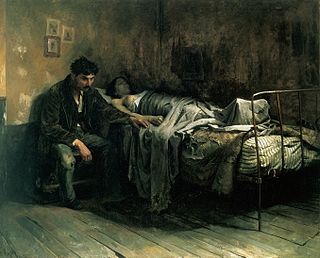
Edvard Munch was a Norwegian painter. His best known work, The Scream, has become one of the iconic images of world art.

Tuberculosis (TB) is an infectious disease usually caused by Mycobacterium tuberculosis (MTB) bacteria. Tuberculosis generally affects the lungs, but can also affect other parts of the body. Most infections show no symptoms, in which case it is known as latent tuberculosis. About 10% of latent infections progress to active disease which, if left untreated, kills about half of those affected. Typical symptoms of active TB are a chronic cough with blood-containing mucus, fever, night sweats, and weight loss. It was historically called consumption due to the weight loss. Infection of other organs can cause a wide range of symptoms.

Christmas seals are labels placed on mail during the Christmas season to raise funds and awareness for charitable programs. They have become particularly associated with lung diseases such as tuberculosis, and with child welfare. Christmas seals are regarded as a form of cinderella stamp in contrast with Christmas stamps used for postage.

A sanatorium is a medical facility for long-term illness, most typically associated with the treatment of tuberculosis (TB) in the late-nineteenth and early-twentieth century before the discovery of antibiotics. A distinction is sometimes made between "sanitarium" or the east-European "sanatorium" and "sanatorium".

The Mercy Brown vampire incident occurred in Rhode Island, US, in 1892. It is one of the best documented cases of the exhumation of a corpse in order to perform rituals to banish an undead manifestation. The incident was part of the wider New England vampire panic.
La Dame aux Camélias is a novel by Alexandre Dumas fils, first published in 1848 and subsequently adapted by Dumas for the stage. The play premiered at the Théâtre du Vaudeville in Paris, France, on February 2, 1852. The play was an instant success, and Giuseppe Verdi immediately set about putting the story to music. His work became the 1853 opera La traviata, with the female protagonist, Marguerite Gautier, renamed Violetta Valéry.

"The Nightingale" is a literary fairy tale written by Danish author Hans Christian Andersen about an emperor who prefers the tinkling of a bejeweled mechanical bird to the song of a real nightingale. When the Emperor is near death, the nightingale's song restores his health. Well received upon its publication in Copenhagen in 1843 in New Fairy Tales. First Volume. First Collection, the tale is believed to have been inspired by the author's unrequited love for opera singer Jenny Lind, the "Swedish nightingale". The story has been adapted to opera, ballet, musical play, television drama and animated film.

Sokołowsko is a village and traditional climatic health resort in Gmina Mieroszów, within Wałbrzych County, Lower Silesian Voivodeship, in south-western Poland. Prior to 1945 it was in Germany. It lies approximately 4 kilometres (2 mi) north-east of Mieroszów, 12 km (7 mi) south of Wałbrzych, and 75 km (47 mi) south-west of the regional capital Wrocław.

Thy Soul Shall Bear Witness! is a 1912 novel by the Swedish author Selma Lagerlöf. It was translated into English by William Frederick Harvey in 1921. Lagerlöf was commissioned to write it by a Swedish association as a means of public education about tuberculosis ("consumption"). It has been dramatized for the screen twice in Sweden and once in France, under various English titles of The Phantom Carriage, The Phantom Chariot, The Stroke of Midnight, and Thy Soul Shall Bear Witness.

Camille is a 1936 American romantic drama film from Metro-Goldwyn-Mayer directed by George Cukor, and produced by Irving Thalberg and Bernard H. Hyman, from a screenplay by James Hilton, Zoë Akins, and Frances Marion. The picture is based on the 1848 novel and 1852 play, La Dame aux Camélias, by Alexandre Dumas. The film stars Greta Garbo, Robert Taylor, Lionel Barrymore, Elizabeth Allan, Jessie Ralph, Henry Daniell, and Laura Hope Crews. It grossed $2,842,000.

The Sick Child is the title given to a group of six paintings and a number of lithographs, drypoints and etchings completed by the Norwegian artist Edvard Munch between 1885 and 1926. All record a moment before the death of his older sister Johanne Sophie (1862–1877) from tuberculosis at 15. Munch returned to this deeply traumatic event repeatedly in his art, over six completed oil paintings and many studies in various media, over a period of more than 40 years. In the works, Sophie is typically shown on her deathbed accompanied by a dark-haired, grieving woman assumed to be her aunt Karen; the studies often show her in a cropped head shot. In all the painted versions Sophie is sitting in a chair, obviously suffering from pain, propped by a large white pillow, looking towards an ominous curtain likely intended as a symbol of death. She is shown with a haunted expression, clutching hands with a grief-stricken older woman who seems to want to comfort her but whose head is bowed as if she cannot bear to look the younger girl in the eye.
Madonna Mary Swan-Abdalla was a Lakota woman. Born on the Cheyenne River Sioux Reservation in South Dakota, USA, Madonna Swan prevailed over extreme difficulties including the Native American tuberculosis epidemic of the 20th century to lead a fulfilled life. She overcame the terrible conditions of socio-economic deprivation, restricted education, poor health care, and confinement to the Indian tuberculosis sanatorium and the reservation, to attend college, become a Head Start teacher, marry, raise a child, and be named Native American Woman of the Year. Madonna Swan become an inspiration to both Indian and non-Indian women.

Alan L. Hart was an American physician, radiologist, tuberculosis researcher, writer, and novelist. He was in 1917–18 one of the first trans men to undergo hysterectomy in the United States. He pioneered the use of x-ray photography in tuberculosis detection and helped implement TB screening programs that saved thousands of lives.

Throughout history, the disease tuberculosis has been variously known as consumption, phthisis, and the White Plague. It is generally accepted that the causative agent, Mycobacterium tuberculosis originated from other, more primitive organisms of the same genus Mycobacterium. In 2014, results of a new DNA study of a tuberculosis genome reconstructed from remains in southern Peru suggest that human tuberculosis is less than 6,000 years old. Even if researchers theorise that humans first acquired it in Africa about 5,000 years ago, there is evidence that the first tuberculosis infection happened about 9,000 years ago. It spread to other humans along trade routes. It also spread to domesticated animals in Africa, such as goats and cows. Seals and sea lions that bred on African beaches are believed to have acquired the disease and carried it across the Atlantic to South America. Hunters would have been the first humans to contract the disease there.

The Minnesota State Sanatorium for Consumptives, also known as the Ah-Gwah-Ching Center, was opened in 1907 to treat tuberculosis patients. The name "Ah-Gwah-Ching" means "out-of-doors" in the Ojibwe language. The center remained a treatment center for tuberculosis until January 1, 1962. During that time, it treated nearly 14,000 patients. In 1962, it became a state nursing home known as the Ah-Gwah-Ching Nursing Home, serving geriatric patients with various mental and physical illnesses. At its peak in the 1970s, the nursing home had as many as 462 patients.
The town of Colorado Springs, Colorado played an important role in the history of tuberculosis in the era before antituberculosis drugs and vaccines. Tuberculosis management before this era was difficult and often of limited effect. In the 19th century, a movement for tuberculosis treatment in hospital-like facilities called sanatoriums became prominent, especially in Europe and North America. Thus people sought tuberculosis treatment in Colorado Springs because of its dry climate and fresh mountain air. Some people stayed in boarding houses, while others sought the hospital-like facilities of sanatoriums. In the 1880s and 1890s, it is estimated that one-third of the people living in Colorado Springs had tuberculosis. The number of sanatoriums and hospitals increased into the twentieth century. During World War II, medicines were developed that successfully treated tuberculosis and by the late 1940s specialized tuberculosis treatment facilities were no longer needed.
The Story Of John M'Neil was Britain's first public health education film, produced in 1911 by Dr Halliday Sutherland. It was a silent film which dramatised a Scottish family living in slum housing and showed how tuberculosis was spread between family members, as well as how it was treated.

Stolta stad! is Epistle No. 33 in the Swedish poet and performer Carl Michael Bellman's 1790 song collection, Fredman's Epistles. One of his best-known works, it combines both spoken and sung sections. In the spoken sections, Bellman, as composer and as performer, imitates a whole crowd of people of many descriptions. It has been described as Swedish literature's most congenial portrait of the country's capital city, Stockholm.
The Straw is a three act play written by American playwright Eugene O'Neill in 1919. The play follows lead characters Eileen Carmody and Stephen Murray during their time at Hill Farm Sanatorium. This was the first of many multi-act plays that O'Neill produced and can be considered semi-biographical.





















